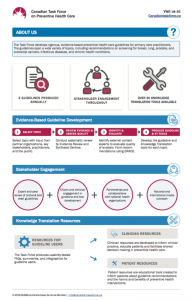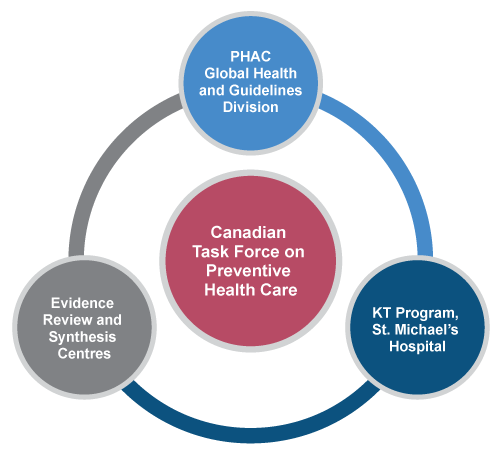About Us
Who We Are
The Canadian Task Force on Preventive Health Care was established by the Public Health Agency of Canada (PHAC) to develop clinical practice guidelines that support primary care providers in delivering preventive health care.
Guideline development is based on systematic analysis of scientific evidence with input from patients and the public, health care practitioners, knowledgeable specialists, health professional associations, health charities, academic institutions and guideline producers in other countries
Why was the Task Force created?
- The Task Force was created to bring together experts with the skills and knowledge to evaluate evidence on complex preventive health care strategies.
- It is an independent, objective, arms-length panel of experts without ties to industry or government.
- The Task Force creates national preventive health care guidelines, based on the latest evidence and with input from a range of experts and key stakeholders including patients and members of the public. Task force recommendations have been recognized nationally and internationally for their rigor and usability with wide adoption in primary care.
Who are the Task Force Members?
- The Task Force is an independent body of 15 primary care and prevention experts from across Canada who recognize and support the need for evidence-informed preventive activities in primary care.
- It consists of family physicians, mental health experts, pediatricians, other physician specialists, experts on prevention, and more. Read the member biographies.
- Each member is thoroughly vetted for conflicts of interest. No current Task Force members receive funding from industry.
- Task Force members volunteer their time and expertise and are not paid for their contributions.
Role of the Task Force
- Guideline topics – Patients and the public may submit topic suggestions year-round, and 100+ organizations are invited to submit topics, including the College of Family Physicians of Canada, health professional associations, health charities, academic institutions, and other relevant parties.
- Evidence – works with Evidence Review and Synthesis Centres in Edmonton and Ottawa to develop key questions, inclusion/exclusion criteria and systematic evaluation of available data for topics.
- Gold standard – uses GRADE, the most widely adopted tool for grading evidence certainty, which provides a systematic and transparent approach for developing and presenting clinical practice recommendations.
- Outside experts – engages specialists and experts in other disciplines on all guideline working groups to ensure that specialty knowledge is integrated with the Task Force’s expertise on screening and prevention.
- Patient and public engagement – in addition to topic suggestions, engages patients and the public within development of each guideline and in development of decision-making tools to support clinicians and patients in clinical practice. Evaluates engagement experience for patients and members of the public.
- Recommendations – based on systematic review of studies to develop evidence-based recommendations.
- Clinical tools – develops tools and materials for each prevention topic to help primary health care providers apply recommendations in practice, led by the Knowledge Translation Program at the Li Ka Shing Knowledge Institute of St. Michael’s Hospital.
- Gaps – identifies evidence gaps and suggests research agendas for new research.
- Publications – regularly publishes guidelines, guideline protocols and systematic evidence reviews in peer-reviewed journals.
Role of Evidence Review Synthesis Centres (Ottawa and Edmonton)
- University of Alberta Evidence Review and Synthesis Centre (ERSC)
- Knowledge Synthesis Group, Ottawa Hospital Research Institute; School of Epidemiology and Public Health, University of Ottawa
- These independent, arms-length centres are responsible for systematically reviewing and analyzing scientific evidence on preventive health topics, providing the Task Force with a state-of-the-art evidence summary on which to base its guidelines. Read more.
Who are the target audiences?
By primary care, for primary care
Primary health care professionals and patients are the Task Force’s primary audience. The Task Force’s guidelines, tools and materials are created “by primary care, for primary care” but are also relevant to a wide range of stakeholders including:
- community and public health professionals
- physician specialists
- other health care and allied health professionals
- program developers
- policy-makers
- the Canadian public
Patient & Public Involvement
- The Task Force consults with members of the public to guide the search for evidence for each guideline, provide feedback on recommendation statements and to co-develop some tools to support patient and clinician decision-making in practice.
Stakeholder Engagement
- Family physicians, nurse practitioners, and other health care professionals, professional health associations, health charities, academic institutions, patients and the public provide input into guideline topics and materials.
- The Task Force also engages these stakeholders in topic selection (over 100 invites to submit topic suggestions), peer review, expert contribution to guideline working groups, engagement in webinars, consultation on guideline implementation, user testing and more.
Structure & Partners




